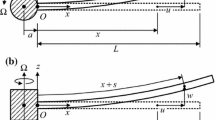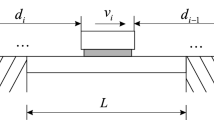Abstract
The dynamic analysis of a generalized linear elastic body undergoing large rigid rotations is investigated. The generalized linear elastic body is described in kinematics through translational and rotational deformations, and a modified constitutive relation for the rotational deformation is proposed between the couple stress and the curvature tensor. Thus, the balance equations of momentum and moment are used for the motion equations of the body. The floating frame of reference formulation is applied to the elastic body that conducts rotations about a fixed axis. The motion-deformation coupled model is developed in which three types of inertia forces along with their increments are elucidated. The finite element governing equations for the dynamic analysis of the elastic body under large rotations are subsequently formulated with the aid of the constrained variational principle. A penalty parameter is introduced, and the rotational angles at element nodes are treated as independent variables to meet the requirement of C 1 continuity. The elastic body is discretized through the isoparametric element with 8 nodes and 48 degrees-of-freedom. As an example with an application of the motiondeformation coupled model, the dynamic analysis on a rotating cantilever with two spatial layouts relative to the rotational axis is numerically implemented. Dynamic frequencies of the rotating cantilever are presented at prescribed constant spin velocities. The maximal rigid rotational velocity is extended for ensuring the applicability of the linear model. A complete set of dynamical response of the rotating cantilever in the case of spin-up maneuver is examined, it is shown that, under the ultimate rigid rotational velocities less than the maximal rigid rotational velocity, the stress strength may exceed the material strength tolerance even though the displacement and rotational angle responses are both convergent. The influence of the cantilever layouts on their responses and the multiple displacement trajectories observed in the floating frame is simultaneously investigated. The motion-deformation coupled model is surely expected to be applicable for a broad range of practical applications.
Similar content being viewed by others
References
Schiehlen, W. Multibody system dynamics: roots and perspectives. Multibody System Dynamics, 1(2), 149–188 (1997)
Shabana, A. A. Flexible multibody dynamics: review of past and recent developments. Multibody System Dynamics, 1(2), 189–222 (1997)
Wasfy, T. M. and Noor, A. K. Computational strategies for flexible multibody systems. Appl. Mech. Rev., 56(6), 553–613 (2003)
Schiehlen, W. Computational dynamics: theory and applications of multibody systems. European Journal of Mechanics A/Solids, 25(4), 566–594 (2006)
Kane, T. R., Ryan, R. R., and Banerjee, A. K. Dynamics of a cantilever beam attached to a moving base. AIAA Journal of Guidance, Control, and Dynamics, 10(2), 139–151 (1987)
Simo, J. C. and Vu-Quoc, L. The role of non-linear theories in transient dynamic analysis of flexible structures. Journal of Sound and Vibration, 119(3), 487–508 (1987)
Wu, S. C. and Haug, E. J. Geometric non-linear substructuring for dynamics of flexible mechanical systems. International Journal for Numerical Methods in Engineering, 26(10), 2211–2226 (1988)
Wallrapp, O. and Schwertassek, R. Representation of geometric stiffening in multibody system simulation. International Journal for Numerical Methods in Engineering, 32(8), 1833–1850 (1991)
Berzeri, M. and Shabana, A. A. Study of the centrifugal stiffening effect using the finite element absolute nodal coordinate formulation. Multibody System Dynamics, 7(4), 357–387 (2002)
Belytschko, T. and Hsieh, B. J. Non-linear transient finite element analysis with convected coordinates. International Journal for Numerical Methods in Engineering, 7(3), 255–271 (1973)
Banerjee, A. K. Block-diagonal equations for multibody elastodynamics with geometric stiffness and constraints. Journal of Guidance, Control, and Dynamics, 16(6), 1092–1100 (1994)
Mayo, J. and Dominguez, J. Geometrically nonlinear formulation of flexible multibody systems in terms of beam elements: geometric stiffness. Computers and Structures, 59(6), 1039–1050 (1996)
Cosserat, E. and Cosserat, F. Théorie des Corps Déformables, Hermann et Fils, Paris (1909)
Toupin, R. A. Elastic materials with couple-stresses. Arch. Rational Mech. Anal., 11(1), 385–414 (1962)
Mindlin, R. D. and Tiersten, H. F. Effects of couple-stresses in linear elasticity. Arch. Rational Mech. Anal., 11(1), 415–488 (1962)
Eringen, A. C. Linear theory of micropolar elasticity. J. Math. Mech., 15(6), 909–923 (1966)
Ottosen, N. S., Ristinmaa, M., and Ljung, C. Rayleigh waves obtained by the indeterminate couple-stress theory. European Journal of Mechanics A/Solids, 19(6), 929–947 (2000)
Fleck, N. A. and Hutchinson, J. W. A reformulation of strain gradient plasticity. Journal of Mechanics and Physics of Solids, 49(10), 2245–2271 (2001)
Chong, A. C., Yang, F., Lam, D. C., and Tong, P. Torsion and bending of micron-scaled structures. J. Mater. Res., 16(4), 1052–1058 (2001)
Stolken, J. S. and Evans, A. G. A microbend test method for measuring plasticity length scale. Acta. Mater., 46(14), 5109–5115 (1998)
Soh, A. K. and Chen, W. Finite element formulations of strain gradient theory for microstructures and the C 0-1 patch test. International Journal for Numerical Methods in Engineering, 61(3), 433–454 (2004)
Wood, R. D. Finite element analysis of plane couple-stress problems using first order stress functions. Int. J. Num. Mech. Engng., 26(2), 489–509 (1988)
Hermann, L. R. Mixed Finite Elements of Couple-Stresses Analysis, John Wiley and Sons, New York, 1–17 (1983)
Fillmore, J. P. A note on rotation matrices. Journal of Computer Graphics and Applications, 4(2), 30–33 (1984)
Palais, B. and Palais, R. Euler’s fixed point theorem: the axis of a rotation. Journal of Fixed Point Theory and Applications, 2(2), 215–220 (2007)
Yang, F., Chong, A. C. M., and Lam, D. C. C. Couple stress based strain gradient theory for elasticity. International Journal of Solids and Structure, 39(10), 2731–2743 (2002)
Author information
Authors and Affiliations
Corresponding author
Additional information
Project supported by the Joint Fund of the National Natural Science Foundation of China and the China Academy of Engineering Physics (No. 11176035), the National Natural Science Foundation of China (No. 11072276), and the National Basic Research Program of China (No. 2011CB612211)
Rights and permissions
About this article
Cite this article
Liu, Zf., Yan, Sj. & Fu, Z. Dynamic analysis on generalized linear elastic body subjected to large scale rigid rotations. Appl. Math. Mech.-Engl. Ed. 34, 1001–1016 (2013). https://doi.org/10.1007/s10483-013-1723-8
Received:
Revised:
Published:
Issue Date:
DOI: https://doi.org/10.1007/s10483-013-1723-8
Key words
- generalized linearly elastic model
- rotational deformation
- dynamics
- motion-deformation coupled model
- finite element method




